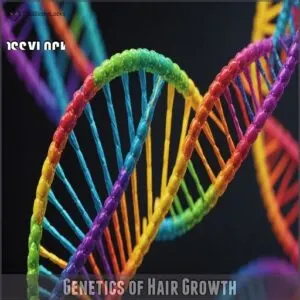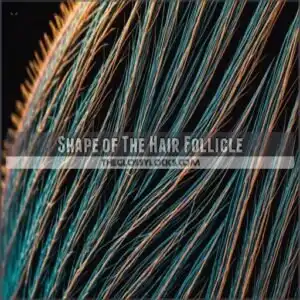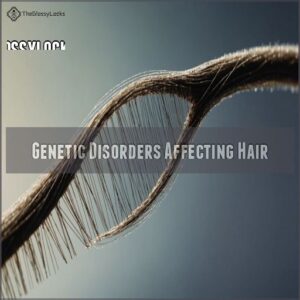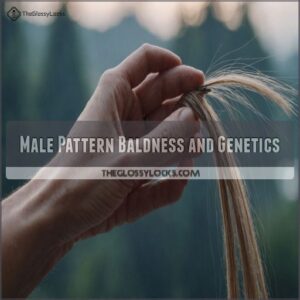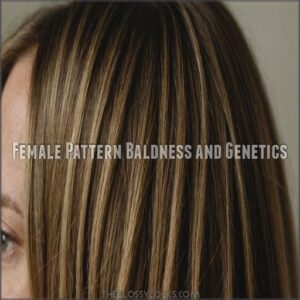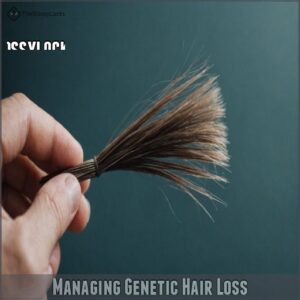This site is supported by our readers. We may earn a commission, at no cost to you, if you purchase through links.
 Yes, hair growth is strongly influenced by your genes, which determine everything from your hair’s thickness and texture to its growth rate and potential for loss.
Yes, hair growth is strongly influenced by your genes, which determine everything from your hair’s thickness and texture to its growth rate and potential for loss.
Your DNA contains specific instructions that control your hair follicles’ behavior, similar to a genetic blueprint that’s been passed down through your family tree.
While you can’t change your genetic code, you can work with it by understanding how your hair naturally grows and responds to different treatments.
Just like your eye color or height, your hair’s characteristics are part of your genetic makeup, but modern science offers promising ways to optimize your hair’s natural potential.
Table Of Contents
- Key Takeaways
- Genetics of Hair Growth
- How Genes Affect Hair Texture
- Genetic Basis of Hair Density and Thickness
- Genetic Disorders Affecting Hair
- Can Genetic Hair Loss Be Reversed?
- Is Hair Length Determined by Genetics?
- Male Pattern Baldness and Genetics
- Female Pattern Baldness and Genetics
- Managing Genetic Hair Loss
- Seeking Professional Help for Hair Loss
- Frequently Asked Questions (FAQs)
- How does genetics affect hair growth?
- Can genetics cause hair loss?
- What are the genetics of hair?
- How are hair traits inherited?
- Is it hereditary for hair growth?
- Is hair genetics from mom or dad?
- Can excessive hair growth be hereditary?
- Can you make your hair thicker or is it genetic?
- Can hair color genetics skip a generation?
- Do environmental factors override genetic hair traits?
- How does ethnicity influence genetic hair patterns?
- Are multiple hair colors on one head genetic?
- Can pregnancy permanently alter genetic hair characteristics?
- Conclusion
Key Takeaways
- Your genes determine fundamental hair characteristics including growth rate, texture, density, and susceptibility to hair loss through proteins like keratin and melanin.
- You can’t change your genetic code, but you can work with it through FDA-approved treatments like minoxidil and finasteride, along with lifestyle changes to optimize your hair’s potential.
- You’ll inherit hair traits from both parents, not just your mother’s side, and these inherited patterns can affect everything from hair follicle shape to hormone sensitivity.
- Your hair’s maximum length is controlled by your genes through the duration of the growth phase (anagen), which typically lasts 2-8 years per follicle.
Genetics of Hair Growth
Your genes control essential aspects of hair growth, including how fast it grows, its texture, and even when you might start losing it.
Through scientific research, we now know that multiple genes work together to influence your hair’s density, thickness, and overall health by regulating important proteins like keratin and hormones that affect your hair follicles.
Role of Genes in Hair Development
Your genes act like a blueprint for your hair’s growth pattern, density, and overall health.
Research shows that DNA influences everything from your hair’s growth cycle to its likelihood of thinning over time.
Understanding your genetic predisposition to certain hair characteristics, such as male pattern baldness, can help you make informed decisions about hair care and treatment options.
Scientists have identified multiple genes that work together to determine your unique hair traits.
Influence of Melanin and Keratin
Hair’s unique character stems from two key proteins: melanin and keratin.
These molecular building blocks work together like nature’s artists and architects.
Melanin acts as your hair’s personal colorist, determining whether you’ll rock raven black or sunny blonde hues.
Meanwhile, keratin serves as the structural engineer, giving your strands their strength and shape.
Together, they create your hair’s distinctive identity.
Genetic Variations and Hair Traits
Genetic variations shape every aspect of your hair, from its growth pattern to its unique traits.
Scientists have identified specific genes that control hair density, texture, and color through the production of proteins and pigments.
These variations explain why you might’ve thick, curly hair while your sibling has fine, straight locks.
Understanding your genetic blueprint can help predict potential changes in your hair’s characteristics over time.
How Genes Affect Hair Texture
Your hair’s texture, whether straight, wavy, or curly, is written in your genes through the shape of your hair follicles.
Hair follicles determine your natural texture.
The KRT71 and PADI3 genes play key roles in determining your hair’s natural texture, influencing how the protein structures form within each strand.
Shape of The Hair Follicle
The shape of each follicle on your scalp determines whether your hair grows straight, wavy, or curly.
Think of follicles as tiny molds that shape each strand from the moment it starts growing.
Here’s what makes follicles fascinating:
- Perfectly round follicles produce pin-straight hair
- Oval-shaped follicles create gentle waves
- Asymmetrical follicles result in spiral curls
- Tilted follicles can cause hair to grow at angles
KRT71 Gene and Curly Hair
Your curly locks can be traced back to variations in the KRT71 gene, which plays a key role in hair texture development.
When this gene undergoes certain changes, it affects how keratin proteins form and stack up inside your hair shaft.
Think of it like a molecular blueprint that determines whether your strands will spiral into beautiful curls or take a different path.
PADI3 Gene and Straight Hair
Scientists have identified the PADI3 gene as a key player in determining your hair’s texture.
When this gene works normally, it helps create straight, sleek locks by affecting how proteins fold within each strand.
For those interested in products that work with their PADI3 gene, there are specialized PADI3 gene hair products.
Here’s what happens when PADI3 is active:
- Hair shaft proteins align perfectly, like soldiers in formation
- Each strand grows smooth and straight from the follicle
- Your hair maintains a uniform shape from root to tip
Genetic Basis of Hair Density and Thickness
You’ll find that the average person has around 80,000 to 120,000 scalp hairs as seen in human hair density. The thickness and density of your hair largely depends on your genetic blueprint, which determines both the number of hair follicles on your scalp and how much keratin your body produces.
Your genes also control the amount of melanin in each strand, with higher melanin levels typically resulting in thicker hair strands.
Number of Hair Follicles on The Scalp
Genetics plays a pivotal role in determining how many hair follicles develop on your scalp.
Research shows that most people are born with around 100,000 follicles, but this number varies considerably based on inherited DNA, which also influences hair density types.
While you can’t create new follicles after birth, understanding your genetic predisposition helps explain why some people naturally have thicker-appearing hair coverage than others.
Keratin Production and Hair Thickness
Beneath each strand of your hair lies a complex process where genes orchestrate keratin production, determining your hair’s thickness.
When your body produces high levels of keratin, you’ll notice:
- Stronger, more resilient strands that resist breakage
- Fuller-looking hair with improved structural integrity
- Enhanced ability to maintain natural moisture levels
Understanding this genetic relationship helps explain why some people naturally have thicker hair strands than others.
Pigmentation Genes and Hair Thickness
Your hair’s thickness is deeply connected to its pigmentation genes.
As these genes control melanin production, they also influence your hair’s structure – more melanin typically means thicker strands.
This explains why people with darker hair often have coarser, thicker strands compared to those with lighter hair.
However, your overall hair density depends on multiple genetic factors beyond just pigmentation.
Genetic Disorders Affecting Hair
Your genes can greatly influence how your hair grows and whether you’ll experience certain hair disorders, from pattern baldness to autoimmune conditions affecting your scalp.
Hair growth and texture can be significantly impacted by your genes.
If you’ve noticed changes in your hair growth or texture, understanding these genetic factors can help you identify potential inherited conditions and explore appropriate treatment options.
Pattern Baldness (Androgenetic Alopecia)
Pattern baldness affects 80% of men and 50% of women by age 80, with genetics playing the leading role.
The AR gene on the X chromosome doubles your risk of hair loss, while DHT sensitivity in hair follicles causes gradual thinning.
If your father experienced balding, you’re likely to share a similar fate – studies show over 80% of people with noticeable hair loss had fathers who also lost their hair.
Alopecia Areata and Autoimmune Disorders
Living with alopecia areata can feel like a rollercoaster, as this autoimmune disorder causes your immune system to mistakenly attack hair follicles.
Research shows that genetic factors play a significant role, with about 20% of patients having a family history of the condition.
While the hair loss patterns may seem random, they’re actually triggered by specific immune responses that scientists are working to understand and treat effectively.
Traction Alopecia and Hair Follicle Damage
When constant pulling strains your hair follicles, traction alopecia can develop, leading to permanent damage.
While genetics may influence susceptibility, this form of hair loss primarily stems from styling habits.
- Tight ponytails and braids create excessive tension
- Extended use of weaves can stress follicles
- Chemical treatments weaken hair structure
- Heavy extensions pull on natural hair
Fortunately, early intervention and gentler styling practices can prevent lasting damage.
Can Genetic Hair Loss Be Reversed?
You can’t completely reverse genetic hair loss, but you can effectively manage and slow it down with proper treatment.
While your genes play a significant role in hair loss, modern medicine offers several options to help you maintain existing hair and stimulate new growth, from FDA-approved medications to surgical procedures.
Treatment Options for Genetic Hair Loss
While genetic hair loss can’t be fully reversed, you’ve got several treatment paths to explore.
Hair transplant surgery moves healthy follicles to thinning areas, offering a permanent solution.
Low-level laser therapy stimulates follicles using red light technology.
Simple lifestyle changes like managing stress, improving nutrition, and gentle hair care practices can help slow down hair loss and support healthier growth.
Medications for Hair Growth
Medications offer hope for those battling genetic hair loss.
Minoxidil and finasteride stand as the two FDA-approved options, each working differently to combat hair thinning.
For those seeking minoxidil hair loss solutions, various products are available online, including those at Minoxidil Hair Loss Products.
Minoxidil increases blood flow to follicles and extends the growth phase, while finasteride blocks DHT production.
Understanding the hair growth cycle helps you set realistic expectations, as results typically appear after 3-6 months of consistent use.
Hair Transplantation Surgery
Hair transplantation surgery offers a permanent solution for genetic hair loss by moving healthy follicles from dense areas to thinning spots. Modern techniques have revolutionized this procedure, making it more effective and natural-looking than ever before.
- FUT (strip method) costs between $4,000-$15,000 and requires 2-3 weeks recovery
- FUE method has a 90% success rate but takes longer to perform
- Most patients see full results within 12-18 months after surgery
Is Hair Length Determined by Genetics?
Your genes control how fast your hair grows and its maximum length by determining the duration of your hair’s growth phase.
While incorporating natural supplements, such as ashwagandha, which may help stimulate keratin production, can promote healthy hair growth, you can’t change your genetic code, you can work with your natural growth cycle to achieve the healthiest possible hair length for your DNA blueprint.
Role of Genes in Hair Growth
Genes play a fascinating role in determining your hair’s growth potential.
Your DNA influences everything from growth rate to the length of your hair’s growth cycle.
The anagen phase plays a key role in this process as it’s the active growth phase lasting 2 to 8 years per follicle.
Some people can grow exceptionally long hair thanks to genes that extend their growth phase, while others have shorter cycles that limit length.
Understanding these genetic factors helps explain why your hair grows differently from others.
Hormonal Influences on Hair Length
Several hormones in your body act like conductors in an orchestra, directing how your hair grows and determining its ultimate length.
Your endocrine system produces these essential chemical messengers that influence your hair’s growth cycle.
- During puberty, androgens can trigger changes in hair texture and growth patterns
- Thyroid hormones regulate the speed of your hair’s growth phase
- Pregnancy and menopause hormones can alter hair thickness and growth rate
Environmental Factors and Hair Length
While genetics set the foundation for your hair’s potential length, external factors play a major role in how long it actually grows.
Your daily choices and environment greatly impact your hair’s journey from root to tip.
| Factor | Impact | Solution |
|---|---|---|
| Diet | Affects protein synthesis | Eat nutrient-rich foods |
| Stress | Disrupts growth cycle | Practice stress management |
| Pollution | Damages hair shaft | Use protective products |
| Climate | Influences moisture levels | Adjust hair care routine |
Male Pattern Baldness and Genetics
If you’ve noticed your hairline changing or thinning on top, your DNA might be playing a significant role through a gene called AR on your X chromosome.
Your risk of male pattern baldness doubles when you inherit this gene, which explains why more than 80% of men with noticeable hair loss have fathers who experienced the same condition.
Role of The AR Gene in MPB
Your hair’s journey is closely linked to the AR gene on the X chromosome.
Research shows you’re twice as likely to develop male pattern baldness (MPB) if you carry specific variations of this gene.
This is because the AR gene plays a key role in regulating androgen hormones, such as DHT effects, which can trigger hair loss.
Think of the AR gene as a lock that can make your hair follicles more sensitive to DHT, a hormone that triggers hair loss.
Understanding your genetic blueprint opens doors to targeted treatment.
Inheritance Patterns of MPB
Research shows that male pattern baldness often runs in families, with inheritance patterns coming from both parents.
Beyond the AR gene, scientists have identified multiple genetic markers that influence your risk.
Here’s what inheritance patterns tell us about MPB:
- Having a father with MPB doubles your risk
- Your mother’s family history matters equally
- Early onset usually indicates stronger genetic factors
- Multiple affected relatives suggest higher susceptibility
Treatment Options for MPB
Medical science offers several proven treatments for male pattern baldness.
From FDA-approved medications like finasteride and minoxidil to advanced procedures like hair transplant surgery and PRP therapy, you’ve got options.
Lifestyle modifications, including proper nutrition and stress management, can support these treatments.
Microneedling, when combined with topical medications, may enhance results by improving absorption and stimulating natural hair growth factors.
Female Pattern Baldness and Genetics
Your genes can influence female pattern hair loss, which affects about half of all women by age 80 and typically appears as gradual thinning along the hair part.
You’ve inherited this trait from both parents, with hormonal changes and aging playing key roles in how your hair follicles respond to DHT, a hormone that can cause hair thinning.
Role of Hormones in FPB
Several hormones orchestrate the complex dance of female pattern baldness, with estrogen levels playing the leading role.
During menopause, declining estrogen can trigger noticeable hair thinning, while androgens like DHT may shrink hair follicles over time.
Thyroid imbalances further complicate matters, as both under and overactive thyroid conditions can disrupt your normal hair growth cycle, leading to gradual hair loss.
Genetic Predisposition to FPB
Your genes play a significant role in determining your risk of female pattern baldness.
If your mother or grandmother experienced FPB, you’re more likely to develop it too.
Scientists have identified multiple genetic markers linked to this condition, with variations in the AR gene being particularly influential.
Environmental factors like stress and nutrition can interact with these genetic predispositions, influencing when and how FPB manifests.
Treatment Options for FPB
After understanding your genetic predisposition, effective treatments for female pattern baldness can help you regain control.
Current science-backed options include:
- FDA-approved topical treatments like minoxidil, which stimulates follicle activity
- Hormone-balancing medications prescribed by specialists
- Advanced procedures such as PRP therapy or hair transplantation
Remember, combining these treatments with targeted lifestyle changes and proper nutrition often yields the best results in managing FPB.
Managing Genetic Hair Loss
While you can’t change your genes, you can take control of genetic hair loss through proven medical treatments and lifestyle changes.
Your journey to managing hereditary hair thinning starts with understanding the available options, from FDA-approved medications to natural remedies that support healthy hair growth.
Lifestyle Changes for Hair Growth
While genetics play a significant role in hair growth, lifestyle changes can help optimize your natural hair potential.
Consider these research-backed strategies for maintaining healthy hair: You can also support your hair growth journey with supplements specifically formulated for hair health, which often contain key nutrients for follicle health.
| Strategy | Benefit | Implementation |
|---|---|---|
| Stress reduction | Lower cortisol levels | Daily meditation |
| Balanced nutrition | Enhanced follicle health | Iron-rich foods |
| Quality sleep | Improved cell regeneration | 7-8 hours nightly |
Think of your hair like a garden – it needs the right conditions to thrive.
Medications for Hair Loss
The most effective medications for genetic hair loss include FDA-approved Minoxidil and Finasteride.
Studies comparing Minoxidil vs. Finasteride effectiveness show that Finasteride can be particularly effective for male pattern baldness by blocking DHT production.
Minoxidil, available over-the-counter, stimulates follicles and extends the growth phase.
Prescription-only Finasteride blocks DHT production, particularly effective for male pattern baldness.
Consider potential side effects and consult a healthcare provider before starting any treatment regimen.
Seeking Professional Help for Hair Loss
You’ll need a medical expert to determine if your hair loss stems from genetics or other factors like hormones, medications, or underlying health conditions.
A board-certified dermatologist can develop a personalized treatment plan using proven options such as medications, laser therapy, or hair transplantation based on your specific needs.
Consulting a Dermatologist
Board-certified dermatologists specialize in diagnosing and treating various hair conditions, making them your best allies in the fight against hair loss.
When you visit one, they’ll examine your scalp under specialized equipment, assess your hair growth patterns, and review your medical history.
They can create a personalized treatment plan that may include prescription medications, light therapy, or other advanced solutions for the best possible results.
Ruling Out Underlying Medical Conditions
Medical conditions like thyroid disorders can be influenced by factors such as hormonal imbalances and hair thinning. Medical conditions like thyroid disorders and **hormonal imbalances can trigger hair loss that mimics genetic patterns.
Before jumping to conclusions, you’ll want a doctor to check your blood work and medical history.
They’ll look for nutritional deficiencies, scalp infections, and review your medications for potential side effects.
Understanding the root cause helps determine whether your hair loss is genetic or treatable.
Treatment Options for Hair Loss
Seeking professional guidance puts you in control of your hair loss journey.
When you visit a hair specialist, they’ll create a personalized treatment plan that might include effective hair growth treatment for alopecia, laser therapy sessions to stimulate dormant follicles, platelet-rich plasma injections for natural growth factors, targeted hair supplements to address nutritional gaps, regular scalp massages to boost circulation, and custom hair care routines using medical-grade products.
You’ll find peace of mind knowing you’re taking evidence-based steps toward healthier hair.
Frequently Asked Questions (FAQs)
How does genetics affect hair growth?
Your genes strongly influence your hair’s growth pattern, thickness, and potential for hair loss.
They control melanin production, follicle shape, and sensitivity to hormones like DHT, which can trigger male pattern baldness.
Can genetics cause hair loss?
Studies show 80% of men experience genetic hair loss by age Your genes influence hair loss through factors like hormones and follicle sensitivity, affecting both men and women throughout their lives.
What are the genetics of hair?
Genetic factors control your hair’s unique traits through DNA instructions that influence melanin production for color, keratin for structure, and follicle shape for texture.
These genes also determine growth patterns and density.
How are hair traits inherited?
Hair traits are passed down through multiple genes from both parents, influencing everything from your hair’s texture and color to its thickness and growth patterns.
You’ll likely share some characteristics with family members.
Is it hereditary for hair growth?
Your rate of hair growth, thickness, and pattern are strongly influenced by genes inherited from both parents.
They control everything from follicle density to growth cycles, affecting how your hair develops over time.
Is hair genetics from mom or dad?
Picture the unique mosaic of your hair pattern – it’s actually inherited from both parents.
The well-known myth about hair genes coming only from your mom’s side isn’t accurate – you’re getting traits from both sides.
Can excessive hair growth be hereditary?
Hypertrichosis, a condition involving excessive hair growth patterns, is often linked to genetic factors. Genetics can definitely influence excessive hair growth, often leading to conditions like hirsutism.
You’ll notice this inherited trait through unusually thick or abundant hair in various body areas, similar to patterns seen in family members.
Can you make your hair thicker or is it genetic?
While you can’t change your genes, you’re not stuck between a rock and a hard place.
You can thicken hair through proper nutrition, hair care products, and treatments like minoxidil or biotin supplements.
Can hair color genetics skip a generation?
Yes, hair color traits can skip generations through recessive genes. You might inherit your grandfather’s red hair even if your parents don’t show it, thanks to complex genetic inheritance patterns.
Do environmental factors override genetic hair traits?
Your genes aren’t destiny’s puppet master regarding hair. Environmental factors like diet, stress, and hair care can greatly impact your genetic predispositions, either enhancing or diminishing your natural hair traits.
How does ethnicity influence genetic hair patterns?
Different ethnic groups inherit distinct hair characteristics through genetic variations, impacting texture, density, and growth patterns.
Black hair tends to be coily.
Asian hair is straight.
European hair varies from straight to wavy.
Are multiple hair colors on one head genetic?
Just like a painter’s palette mixing colors naturally, genetic variations in melanin production can create multiple hair colors on one head.
Genes control melanocyte activity differently across your scalp, resulting in natural highlights.
Can pregnancy permanently alter genetic hair characteristics?
Pregnancy hormones can permanently change your hair’s texture, thickness, and curl pattern.
While temporary changes are common, some women experience lasting alterations due to hormonal shifts that modify gene expression in hair follicles.
Conclusion
Ready to take control of your hair’s destiny?
While your genes play a major role in determining how your hair grows, hair growth can also occur unexpectedly due to external factors such as wound-induced hair growth, understanding the genetic factors behind hair growth empowers you to make informed decisions about hair care and treatment options.
Whether you’re dealing with hair loss or seeking to optimize your hair’s natural potential, remember that genetics isn’t always destiny.
With modern science and professional guidance, you can work with your DNA to achieve the best possible outcomes for your hair health.

